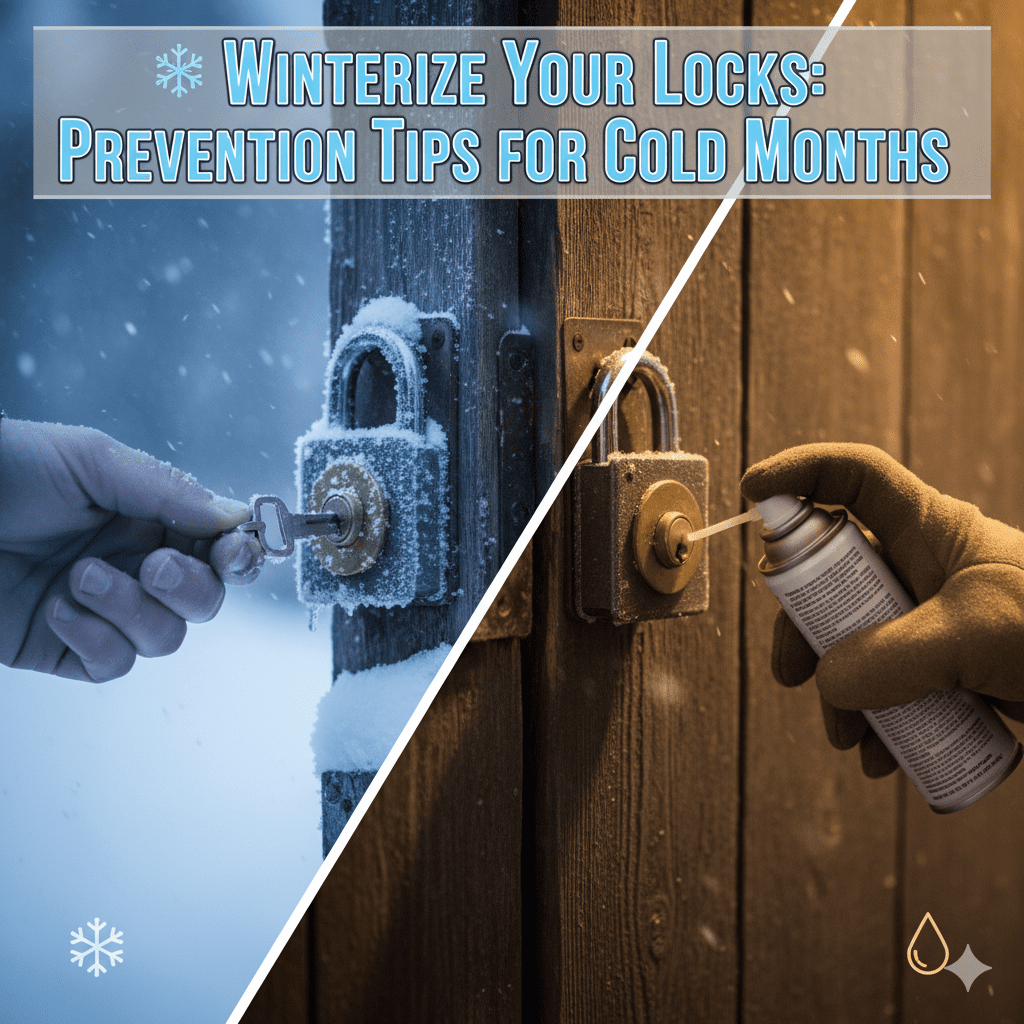When winter hits the cold does not the temperature drop just bite your fingers — it can freeze your locks solid. Weather when your locks can freeze, jam, or even break. That’s why it’s essential to winterize your locks before the cold weather takes over. Whether it’s your home, office, or car, taking preventive steps can save you time, stress, and money during the icy months.
Let’s look at how to keep every lock working smoothly, even on the coldest days of winter.
Why You Should Winterize Your Locks
Bitter cold can make metal locks swell, stick, or turn stiff under your fingers. Moisture seeps into the keyhole, and by morning it’s frozen solid, so the key won’t even turn. In cold weather, metal contracts just enough to make a lock feel tight and stubborn — sometimes snapping a key with a sharp, unpleasant crack..
Taking time to winterize your locks now prevents bigger problems later. It also extends the life of your locks and reduces wear from harsh winter conditions.
If you’re unsure where to start, the experts at keyitlocks. can help you choose the best lock care products and provide professional locksmith services in winter.
Simple Ways to Prevent Frozen Locks in Winter
One of the simplest door lock maintenance tips is to clean and lubricate locks regularly. Over time dust and dirt collected inside the keyways making it harder for keys to turn especially when it’s freezing outside.
Try these smart prevention tips:
- Clean the keyhole first. Use a soft brush or compressed air to remove dust.
- Lubricate with graphite or silicone spray. These create a protective barrier against moisture(avoid oil based spray) .
- Cover outdoor locks. Use small lock covers or even tape during snowstorms.
- Avoid water. Never pour hot water on a frozen lock; it just refreezes later.
- Check weather stripping. It stops snow and rain from entering the lock area.
If you want your door lock to work smoothly all winter, give it a quick shot of lubricant before the cold sets in and every couple of weeks after — just enough to keep the key turning without a hitch.
Protect Outdoor and Car Locks from Freezing
Carlocks freeze faster than home locks because they’re constantly exposed. The best car lock freezing solutions involve keeping moisture away.
Try these steps:
- Use a lock cover or wrap to keep out rain and snow.
- Warm your car key gently before inserting it.
- Keeping a de-icer for locks in your glove bag — it quickly melts ice buildup.
- For house doors, use weather stripping to prevent water from getting into locks.
- Using a silicone lubricant designed for automotive locks.
If your key won’t turn, don’t force it — you might snap it. Instead, use a frozen car key fix product or warm your key slightly with your hands before trying again.
5. Use the Right Products to Winterize Locks
There are tons of lock care sprays on the market but not all are winter-safe. The right tools make a big difference in winter lock care. Here’s what professionals recommend:
- Graphite powder: keeps lock dry and smooth.
- Silicone spray: Grapples water and ice build up.
- Weatherproof padlocks – perfect for gates or sheds.
- Anti-freeze lock de-icers – keep one handy for emergencies.
When in doubt, call for details and contact-us to ask which product is right for your specific locks — especially if you use smart or high-security ones.
Indoor Locks Need Care Too
It’s easy to forget that indoor locks also feel the impact of cold, especially in entryways or garages where temperatures fluctuate.
- Keep your indoor locks clean and give them a light touch of oil so they turn smoothly.
- Don’t crank door handles or locks too tight in winter—it’s cold enough for the metal to shrink.
- Check the hinges and tighten the screws, making sure they line up straight—no gaps, no wobble.
Following these house door freezing prevention steps keeps your doors working smoothly all year long.
Long-Term Protection for Locks and Keys
If your winters bite with icy winds, it’s wise to plan ahead. Protecting your outdoor padlock with a winter cover or swapping it for a weatherproof lock keeps you from wrestling with a frozen latch year after year.
Keep your spare keys in a warm, dry spot—inside a desk drawer works—to protect them from moisture, and give the locks a quick rust check when winter’s over.
By creating a yearly routine, you’ll keep your locks strong, reliable, and ready for every season.
When to Call a Professional Locksmith
Sometimes, despite all precautions, locks still freeze or jam. In that case, don’t panic — call an expert. Professional locksmiths have special tools to safely unfreeze locks without causing damage.
If your lock is already frozen or broken, reach out for locksmith services in winter from Key It Locks. They can:
- Unlock frozen doors quickly
- 24/7 emergency lockout help
- Long lasting locks protect locks from cold weather solutions.
- Replace damaged locks
- Recommend cold-weather resistant hardware
FAQs
1. Can I use WD-40 on my locks in winter?
It’s not recommended. WD-40 is oil-based and can attract dirt, which causes buildup. Use graphite or silicone spray instead.
2. What should I do if my lock freezes overnight?
Use a lock de-icer or gently warm your key. Never pour hot water on the lock — it can refreeze.
3. How often should I lubricate locks during winter?
Once every two weeks during freezing months is ideal.
4. Are electronic locks affected by cold?
Yes, extreme temperatures can slow or drain batteries. Keep spare batteries handy.
Conclusion
Take a little time to winterize your locks, and you’ll avoid frozen doors, snapped keys, and the sting of paying for repairs on a bitter January morning. Keep your locks smooth and secure this winter by cleaning them well, adding a bit of oil, and giving them regular checkups—like wiping away grit before it freezes.
If you ever need expert help or professional advice, contact keyitlocks — your trusted locksmith service for winter protection, repairs, and maintenance.







